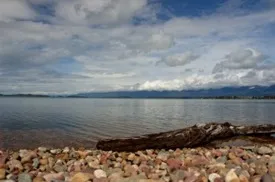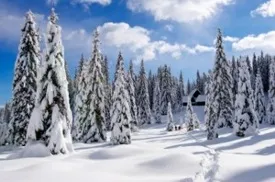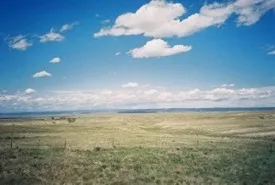Wyoming’s landscape is defined by its impressive mountain ranges and expansive high plains, resulting in a distinctive climate. With a mean elevation around 6,700 feet above sea level, the state experiences unique weather patterns. Even outside the mountains, the southern plains sit above 6,000 feet, while the northern regions are significantly lower. This diverse topography plays a crucial role in shaping the Wyoming State Climate.
The lowest point in Wyoming is 3,125 feet in the northeast, near the South Dakota border, where the Belle Fourche River flows out of the state. The highest point is Gannett Peak at 13,785 feet in the Wind River Range. Since major mountain ranges run north-south, they act as barriers to the prevailing westerlies, forcing moisture to fall on the western slopes. East of the mountains, the state is largely semiarid.
Despite the mountains, the high plains cover a larger area. The varying elevations make it challenging to divide Wyoming into uniform climatological zones, contributing to the complexity of the Wyoming State Climate.

The Continental Divide traverses the state, sending most of the drainage eastwards. Run-off feeds into three major river systems: the Columbia (via the Snake in the northwest), the Colorado (via the Green River in the southwest), and the Missouri (via the Yellowstone, Wind River, Big Horn, Tongue, and Powder in the north, and Belle Fourche, Cheyenne, Niobrara, and Platte in the east/southeast).
A small area along the southwest border drains into the Bear River, which flows to the Great Salt Lake. The Great Divide Basin, including the Red Desert, west of Rawlins in the south-central area, has no external drainage. Annual precipitation here is low, averaging 7 to 10 inches, with water either evaporating or percolating into the ground.


Significant snow accumulates in the high mountains. This melting snow feeds streams, providing water for irrigation, power generation, and domestic use across the state.


Rapid run-off from heavy thunderstorms can cause flash flooding, especially on headwater streams. This flooding is intensified if it coincides with snowmelt, potentially causing considerable damage in nearby communities. These natural processes are integral to the dynamic Wyoming State Climate.
Temperature Patterns in Wyoming
Due to its high elevation, Wyoming generally has a cool climate. Temperatures above 6,000 feet seldom exceed 100°F. Warmer areas are typically the lower Big Horn Basin, parts of the central and northeast, and along the eastern border. The state’s record high is 114°F, set on July 12, 1900, at Basin.
Basin’s average maximum temperature in July is 92°F. Across most of Wyoming, mean maximum temperatures in July range from 85 to 95°F. Higher elevations see rapid drops in average temperatures; areas around 9,000 feet might have July maximums near 70°F. Summer nights are almost always cool.
Finding Your Perfect Amateur Astronomy Telescope – Expert Guide 2025
Discover the Best Michigan Places to Visit for Unforgettable Adventures in 2024
Discover the Top 11 nevada places to visit
Away from the mountains, mean minimum temperatures in July generally range from 50 to 60°F. Mountains and high valleys are much cooler, with average lows in the 30s and 40s in mid-summer, sometimes dropping below freezing. The temperature variations are a key aspect of the Wyoming State Climate.
Winter brings frequent, rapid temperature shifts between mild and cold spells. Cold waves, typically fewer than 10 per winter, often move south on the east side of the Divide, sometimes affecting only the northeast as cold air spreads east over the plains. Many cold waves lack significant snow.
January, usually the coldest month, sees mean minimum temperatures mostly between 5 and 10°F. Western valleys can drop to about -5°F. The state record low is -66°F, recorded February 9, 1933, at Yellowstone Park. Mild winter spells can push nighttime temperatures above freezing. Chinooks, warm downslope winds, are common on eastern slopes.
Valleys are prone to cold air drainage at night, as surrounding mountains block wind, allowing cold, heavy air to settle. Temperatures in valleys are often much lower than on nearby mountain sides. Big Piney in the Green River Valley is an example.
Mean January temperatures in the Big Horn Basin illustrate elevation’s effect: Worland and Basin (around 4,000 feet) have mean January minimums of zero, while Cody (near 5,000 feet) has 11°F. Winters are typically long and cold, though occasional mild periods with maximums in the 50s occur in January. These fluctuations define the winter Wyoming State Climate.
Growing Season Length
Early fall and late spring freezes are common, resulting in long winters and short growing seasons in Wyoming. However, there are frequent shifts between cold and mild periods throughout fall, winter, and spring.
The average freeze-free period (growing season) for major agricultural areas is around 125 days. For hardier plants tolerating 28°F or slightly lower, the growing season east of the Divide is approximately 145 days.
Mountain and high valley areas can experience freezing temperatures any time during summer. Tender plants have almost no growing season in areas like the upper Green River Valley, Star Valley, and Jackson Hole. At Farson, near Sandy Creek, the average is just 42 days between the last 32°F reading in early summer and the first freeze in late summer. Star Valley and Jackson Hole often have even shorter seasons, a significant characteristic of the Wyoming State Climate in these regions.
Sunshine Levels and Intensity
Most of Wyoming receives abundant sunshine, ranging from about 60% of possible in winter to around 75% in summer. Mountain areas receive less, with northwestern mountains estimated at about 45% in winter.
In summer, when sunshine is strongest, mornings are typically clear. Cumulus clouds often develop afternoons, temporarily blocking the sun. The intensity of sunshine is unusually high due to the altitude, meaning less atmosphere for rays to penetrate, and minimal fog, haze, or smoke. This high solar intensity is a notable feature of the Wyoming State Climate.
Precipitation Variations
Like other western states, precipitation in Wyoming varies greatly by location. The period of maximum precipitation is generally spring and early summer across most of the state. Higher elevations and mountain ranges receive more precipitation, though elevation isn’t the sole factor.
For example, the southwest portion, at 6,500-8,500 feet, averages only 7 to 10 inches annually. Lower elevations in the northeast and along the eastern border (4,000-5,500 feet) average 12 to 16 inches. The dry southwest is a high plateau surrounded by mountains.
The Big Horn Basin shows how mountains block moisture. Its lower portion is the driest area, getting 5 to 8 inches annually. Seaver, at 4,105 feet, averages about 5.50 inches. Worland (4,061 feet) in the southern basin averages 7 to 8 inches, compared to Thermopolis (4,313 feet) with 11 to 12 inches.
Another example is southeastern Wyoming: Laramie (7,236 feet) averages 10 inches annually, while Centennial (8,074 feet), 30 miles west, receives about 16 inches. Few locations record as much as 40 inches per year.
Summer showers are frequent but often light, a few hundredths of an inch. Occasionally, heavy rain occurs with thunderstorms over small areas. Several local storms annually bring 1 to 2 inches in 24 hours. Rarely, 24-hour totals reach 3 to 5 inches; the record is 5.50 inches at Dull Center (near Newcastle) on May 31, 1927. Precipitation patterns significantly shape the Wyoming State Climate.
Humidity and Evaporation
Wyoming’s average relative humidity is quite low, contributing to pleasant summer weather. During warm summer afternoons, humidity often drops to 25-30%, sometimes even 5-10%. Late at night, humidity rises to 65-75% as temperatures fall.
This creates an average daily humidity variation of 40-45% in summer; winter variation is much less. Low relative humidity, high sunshine, and strong winds contribute to a high evaporation rate. Consistent evaporation records are hard to get outside May-September due to freezes.
From May through September, average evaporation from pans is about 41 inches, ranging from 30 to 50 inches at selected sites. This high evaporation rate is a key factor in the semiarid aspects of the Wyoming State Climate.
Severe Weather Phenomena
Hailstorms are Wyoming’s most destructive local storm type, causing thousands in crop and property damage annually. While some hit cities, most pass over open rangeland with slight impact. Small areas of cropland can be completely lost to hail.
Tornadoes occur but are less frequent and destructive than in the Midwest, partly because much of Wyoming is open, sparsely populated range. Wyoming tornadoes are generally smaller and shorter-lived, often touching down for only minutes before retreating into clouds.
The tornado season runs April-September, peaking in June, followed by May, mostly in the eastern part of the state. While less frequent than elsewhere, they are a consideration in the Wyoming State Climate.
Wyoming is quite windy. Winter often brings periods with winds reaching 30-40 mph and gusts up to 50-60 mph. Prevailing winds vary locally but are generally from the west, west-southwest, or northwest.
In many areas, winds are so strong and constant from these directions that trees exhibit a noticeable lean towards the east or southeast, demonstrating the powerful influence of wind on the local environment and contributing to the characteristics of the Wyoming State Climate.
Snowfall and Blizzards
Snow falls frequently from November through May. At lower elevations, snowfall is typically light to moderate. On average, lower elevation stations receive over 5 inches of snow about five times per year.
Falls of 10-15 inches or more from a single storm are infrequent outside mountain areas. Wind often accompanies or follows snowstorms, creating drifts several feet deep. Drifting can make accurate snowfall measurement difficult.
An exceptionally heavy snow occurred at Sheridan on April 3-4, 1955, with 39.0 inches of snow (4.30 inches water equivalent) and blizzard conditions lasting over 43 hours. High winds, low temperatures, and snow cause blizzard or near-blizzard conditions. These may last a day or two; severe blizzards rarely exceed three days, impacting travel and daily life under the Wyoming State Climate.
Total annual snowfall varies significantly. Lower elevations in the east receive 60-70 inches. The drier southwest gets 45-55 inches. The Big Horn Basin has very light snow, 15-20 inches in the lower part, and 30-40 inches on the basin sides (5,000-6,000 feet elevation).
Mountains receive much more snow, with higher ranges getting well over 200 inches annually. Beckler River Ranger Station in southwest Yellowstone Park averages 262 inches over a 20-year period. This heavy mountain snowpack is crucial for the state’s water supply.
The weather pattern most conducive to precipitation involves a low-pressure center just south of Wyoming, causing cooler surface air to be overrun by warmer, moist air. Wind flow studies suggest Wyoming is primarily under Pacific air influence. Cold air masses from Canada affect the state a smaller percentage of the time, shaping the diverse conditions of the Wyoming State Climate.
Experiencing the Wyoming State Climate means being prepared for its dramatic shifts and regional variations, from the high mountain snows to the dry plains.
